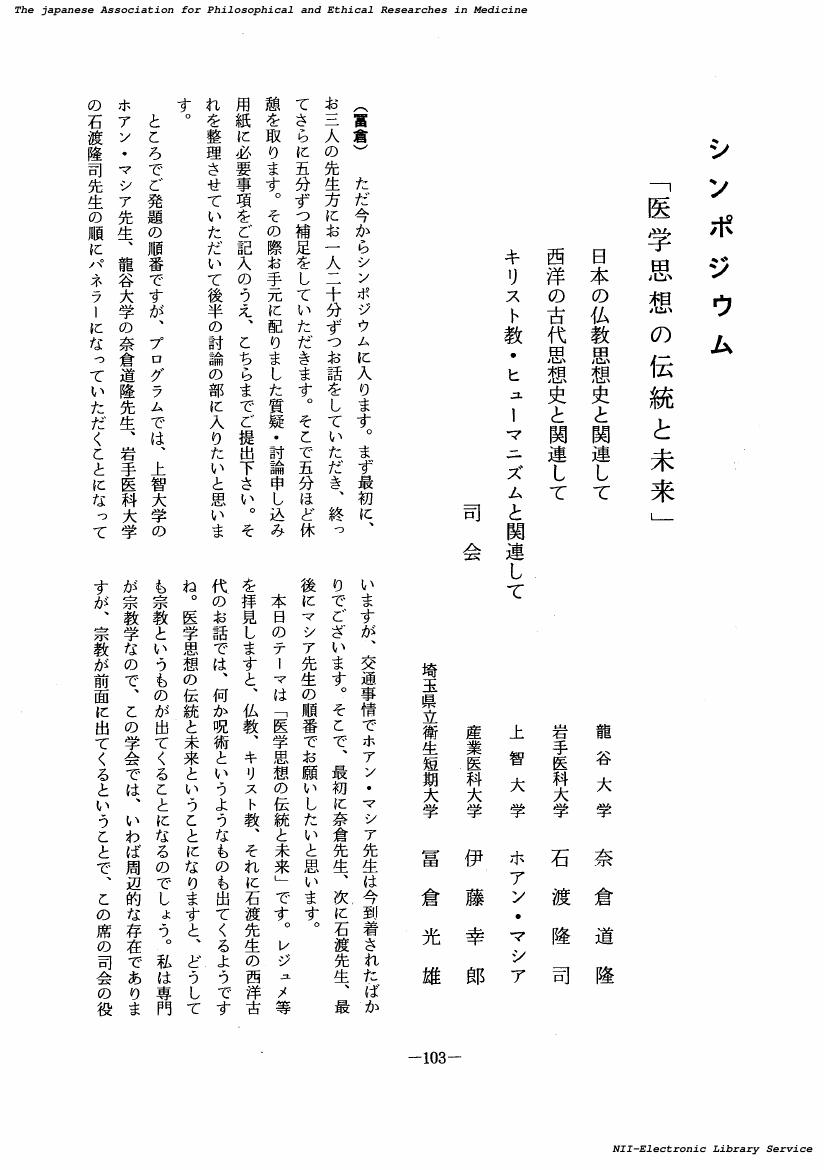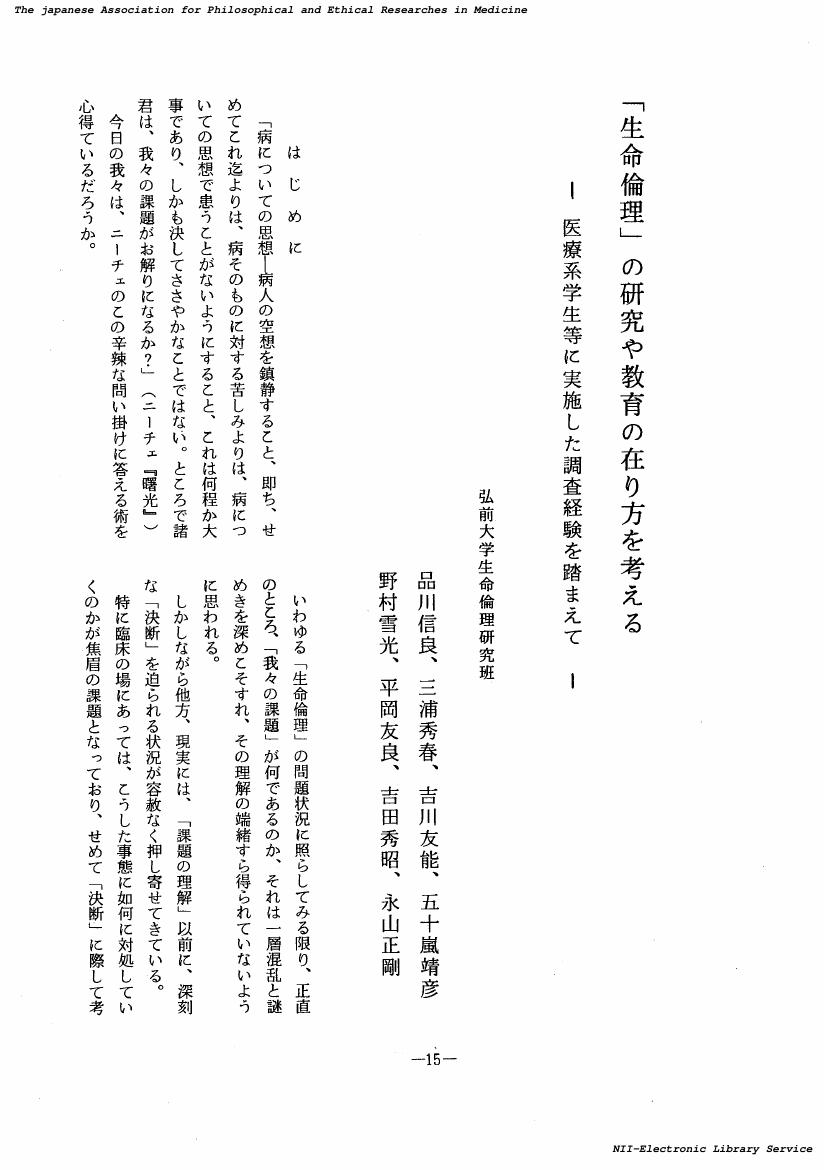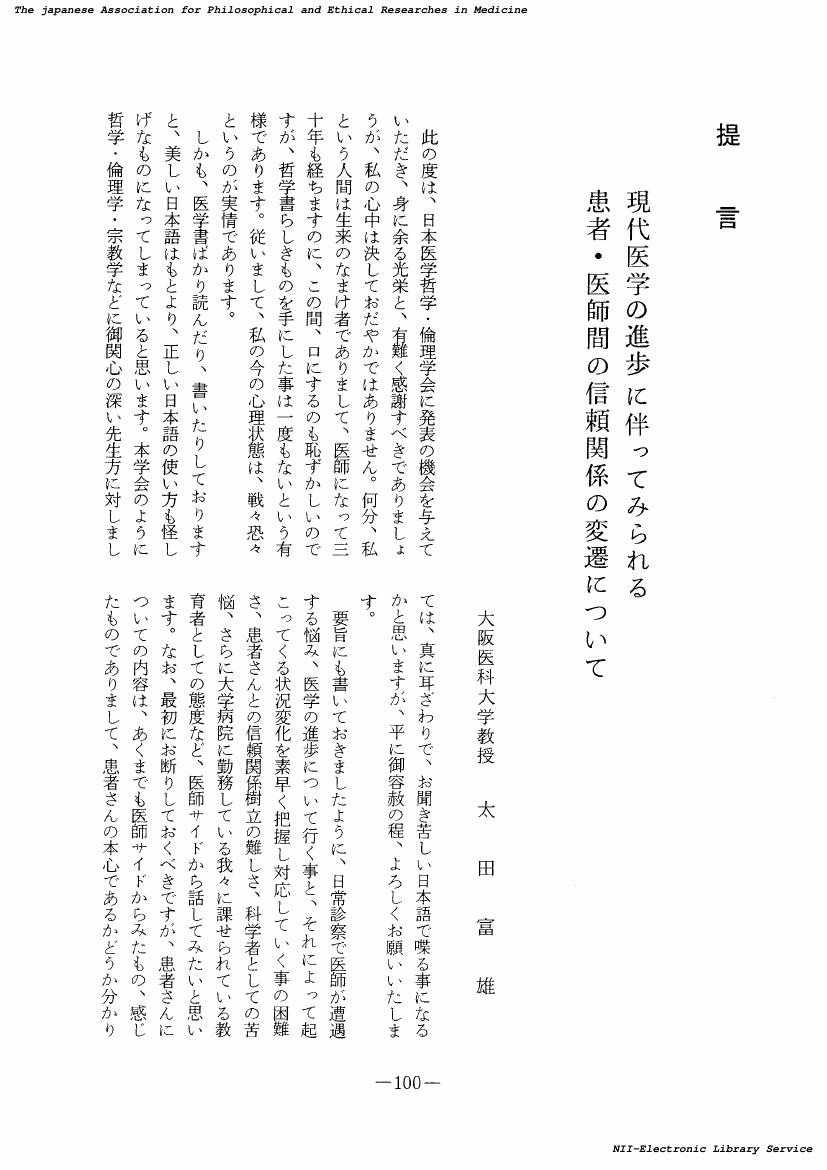1 0 0 0 OA 医学思想の伝統と未来
- 著者
- 奈倉 道隆 石渡 隆司 マシア ホアン 伊藤 幸郎 冨倉 光雄
- 出版者
- 日本医学哲学・倫理学会
- 雑誌
- 医学哲学 医学倫理 (ISSN:02896427)
- 巻号頁・発行日
- vol.6, pp.103-130, 1988-07-31 (Released:2018-02-01)
1 0 0 0 OA 中国古代医学の価値観を論ず
- 著者
- 範 以農 森下 利明
- 出版者
- 日本医学哲学・倫理学会
- 雑誌
- 医学哲学 医学倫理 (ISSN:02896427)
- 巻号頁・発行日
- vol.6, pp.145-151, 1988-07-31 (Released:2018-02-01)
1 0 0 0 OA 情報構造としての宇宙
- 著者
- 品川 嘉也 菊池 美也子
- 出版者
- 日本医学哲学・倫理学会
- 雑誌
- 医学哲学 医学倫理 (ISSN:02896427)
- 巻号頁・発行日
- vol.7, pp.21-30, 1989-07-31 (Released:2018-02-01)
The time of the big bang (the birth of the universe) has been considered in this report in terms of infor-mation structure theory. Information structure theory shows that all structures in the universe were created by information; the universe has developed through cycles of energy, information and matter. The universe itself was created by information. At least three conditions are necessary to create the universe: the existence of principle(s), fluctuation, and time-space. The authors consider the uncertainty principle of time and energy, Δt・ΔE>ℏ/2, where &ℏ is Plank's constant. If the total energy of the universe, 10^<79> erg, was created by the fluctuation, ΔE, then the time of the big bang is obtained as Δt>5.27 ×10^<-107>sec. This means there was a break down of equilibrium of vacuum space. The non-equilibrium of space must have information and entropy. So, information is the origin of the structure called the universe.
1 0 0 0 OA 医の倫理とその教育
- 著者
- 伊藤 幸郎
- 出版者
- 日本医学哲学・倫理学会
- 雑誌
- 医学哲学 医学倫理 (ISSN:02896427)
- 巻号頁・発行日
- vol.7, pp.42-53, 1989-07-31 (Released:2018-02-01)
Medicine has been fundamentally humanistic and ethical in its nature since its origin. It is not a pure science, as is erroneously held by most modern Japanese medical researchers. It is an applied science endowed with evident objectives, i.e. healing diseases and promoting the health of people. Moreover, "disease" and "health" are both value-laden concepts. Human conduct is judged as good or evil according to some value-laden criteria, so it is impossible to separate medicine from ethics. The word "ethics" is derived from Greek "ethos", which originally meant the custom of the people. Customs are different according to time, race, religion etc.. There is not one single ethic on this earth but there are plural ethics. This pluralism of ethics is fitted to modern democratic societies. In the field of medical ethics, current Japanese press comments are unduely concentrated on the up-to- date problems arising from high technologies (e.g.in vitro fertilization, brain death, organ transplantation etc.) However, these topics cover only partial and extraordinary phenomena in the whole of medical practice. We should rather pursue "daily medical ethics" based on everyday encounters of doctors and patients. Above all, reconsideration of the usual doctor's paternalism and popularization of informed consent throughout the medical world in Japan are urgent issues. The medical humanities have been taught in the University of Occupational and Environmental Health for 1st to 6th year medical students as a required course since the beginning of the university (1978). Some defects of lectures as mere delivery of knowledge were criticized and several new teaching techniques have been introduced. For example, in their "early exposure", freshmen are asked to attend to disabled children for 24 hours, and in "nursing practice", 5th year students are assigned to the nursing teams in the university hospital as apprentices. Through these practices the students learn by their own experiences how to find ethical problems in actual medical practice and promote their sensitivity to sick people. These techniques in the education of medical ethics as applications of behavioral sciences will develop further in Japanese medical education.
1 0 0 0 OA 医学生の生命倫理観・生命観について : 人体解剖感想文から
- 著者
- 牧野 尚哉
- 出版者
- 日本医学哲学・倫理学会
- 雑誌
- 医学哲学 医学倫理 (ISSN:02896427)
- 巻号頁・発行日
- vol.7, pp.31-41, 1989-07-31 (Released:2018-02-01)
Some years ago, the author investigated the ethical basis of the biological experiments to the medical students. So, author obtained that they had highly the ethical consciousness to animals and plants. Now, author made a plan to clarify the ethical consiousness of the medical students. Author employed the record of student's impressions after the dissection of human body. Author systematized their records as 25 items, namely, mental strain and surprise,thanks to human remains, the spirit of human remains, the dignity of man, the mystery of life, the fine structure of human body and so on. It made more meaning-ful that the medical students had a meeting chance with the obligors of registration to the dissection before the anatomical practice. Author felt indeed that students comprehend the mind of human remains and the family of human remains, through the dissection from their records. Perhaps, students felt as a living person about image of a human remains for her hair-pin and the knife-cut in the operation of remains. Many students think the anatomical practice of human remains to very important task to be the doctor, because, many students are strained, -think the mind of remains, - thank the remains for the public spirited, mind, - get high understanding to the fine structure of human body
1 0 0 0 OA バイオエシックスの基礎 : 医学と医療政策における適正な意志決定法への試論
- 著者
- エンゲルハート H.トリストラム 伊藤 幸郎
- 出版者
- 日本医学哲学・倫理学会
- 雑誌
- 医学哲学 医学倫理 (ISSN:02896427)
- 巻号頁・発行日
- vol.6, pp.131-144, 1988-07-31 (Released:2018-02-01)
1 0 0 0 OA 脳と無限情報処理
- 著者
- 曽我 英彦
- 出版者
- 日本医学哲学・倫理学会
- 雑誌
- 医学哲学 医学倫理 (ISSN:02896427)
- 巻号頁・発行日
- vol.6, pp.1-14, 1988-07-31 (Released:2018-02-01)
1 0 0 0 OA 臨床医の立場から
- 著者
- 近藤 俊朗
- 出版者
- 日本医学哲学・倫理学会
- 雑誌
- 医学哲学 医学倫理 (ISSN:02896427)
- 巻号頁・発行日
- vol.6, pp.80-90, 1988-07-31 (Released:2018-02-01)
1 0 0 0 OA 「生命倫理」の研究や教育の在り方を考える : 医療系学生等に実施した調査経験を踏まえて
1 0 0 0 OA 死の形而上学素描
- 著者
- 矢次 正利
- 出版者
- 日本医学哲学・倫理学会
- 雑誌
- 医学哲学 医学倫理 (ISSN:02896427)
- 巻号頁・発行日
- vol.6, pp.28-40, 1988-07-31 (Released:2018-02-01)
1 0 0 0 OA 中国医学倫理学会に参加して(中国第四次全国医学倫理学学術討論会参加報告)
- 著者
- 杉田 勇
- 出版者
- 日本医学哲学・倫理学会
- 雑誌
- 医学哲学 医学倫理 (ISSN:02896427)
- 巻号頁・発行日
- vol.5, pp.155-157, 1987-07-10 (Released:2018-02-01)
1 0 0 0 OA 生命倫理学が中国医学倫理学研究の現況に与える示唆
- 著者
- 石 大璞
- 出版者
- 日本医学哲学・倫理学会
- 雑誌
- 医学哲学 医学倫理 (ISSN:02896427)
- 巻号頁・発行日
- vol.5, pp.148-154, 1987-07-10 (Released:2018-02-01)
1 0 0 0 OA 新しい身体像の構築のために
- 著者
- 川田 殖 品川 嘉也 平山 正実 石渡 隆司 大槻 真一郎
- 出版者
- 日本医学哲学・倫理学会
- 雑誌
- 医学哲学 医学倫理 (ISSN:02896427)
- 巻号頁・発行日
- vol.5, pp.110-147, 1987-07-10 (Released:2018-02-01)
1 0 0 0 OA シュレーディンガーの生命観 : 『生命とは何か』をめぐって
- 著者
- 大林 雅之
- 出版者
- 日本医学哲学・倫理学会
- 雑誌
- 医学哲学 医学倫理 (ISSN:02896427)
- 巻号頁・発行日
- vol.6, pp.41-51, 1988-07-31 (Released:2018-02-01)
1 0 0 0 OA 老年の医療と仏教思想 : 新時代の医学思想を求めて
- 著者
- 奈倉 道隆
- 出版者
- 日本医学哲学・倫理学会
- 雑誌
- 医学哲学 医学倫理 (ISSN:02896427)
- 巻号頁・発行日
- vol.5, pp.89-97, 1987-07-10 (Released:2018-02-01)
1 0 0 0 OA 仏教に於ける死と医の一考察
- 著者
- 岡本 天晴
- 出版者
- 日本医学哲学・倫理学会
- 雑誌
- 医学哲学 医学倫理 (ISSN:02896427)
- 巻号頁・発行日
- vol.5, pp.61-77, 1987-07-10 (Released:2018-02-01)
1 0 0 0 OA 脳死と人間の死
- 著者
- 伊藤 幸郎
- 出版者
- 日本医学哲学・倫理学会
- 雑誌
- 医学哲学 医学倫理 (ISSN:02896427)
- 巻号頁・発行日
- vol.5, pp.78-88, 1987-07-10 (Released:2018-02-01)
1 0 0 0 OA 医学概論について
- 著者
- 澤潟 久敬
- 出版者
- 日本医学哲学・倫理学会
- 雑誌
- 医学哲学 医学倫理 (ISSN:02896427)
- 巻号頁・発行日
- vol.5, pp.1-9, 1987-07-10 (Released:2018-02-01)
1 0 0 0 OA 日本の産婦人科医が現在かかえている医療倫理上の諸問題
- 著者
- 品川 信良
- 出版者
- 日本医学哲学・倫理学会
- 雑誌
- 医学哲学 医学倫理 (ISSN:02896427)
- 巻号頁・発行日
- vol.5, pp.48-60, 1987-07-10 (Released:2018-02-01)
1 0 0 0 OA 現代医学の進歩に伴ってみられる患者・医師間の信頼関係の変遷について(臨床医学の立場から)
- 著者
- 太田 富雄
- 出版者
- 日本医学哲学・倫理学会
- 雑誌
- 医学哲学 医学倫理 (ISSN:02896427)
- 巻号頁・発行日
- vol.5, pp.100-109, 1987-07-10 (Released:2018-02-01)
















